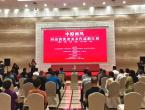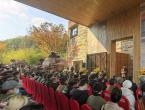Tongren Jin Xinming
2025-10-25 20:48:56 ■ Lin Xiaofeng
Jin Xinming is an artist who excels in poetry, calligraphy, painting, and printing. In terms of painting, he is very skilled in landscapes, flowers, birds, and figures. With a stroke of his pen, the paper also exuded a sense of free growth. This is not a taste of indulgence, but a sense of relaxation in the literati atmosphere, slowly expressed from the heart.
Everyone also says that Jin Xinming is a good friend, and it's good that he is genuine. Helping others is also very dedicated. He is enthusiastic, but not polite. He has the crisp and refreshing taste of Yiwu people. He can help you get things done in a few moments and won't come to take credit. Make you feel that the completion of things is inspired by your own "personal charm".
Of course, humans are the sum of social relationships. Especially for painters, they need to participate in various exhibitions, pen clubs, and social events, either voluntarily or by invitation. Therefore, there are also interesting portraits of painters. Some people are arrogant and proud of themselves before painting; Some pretend to be humble, indicating that they still need to work hard; Some are full of officialdom and often use mainstream narratives; Some painters are shy and reserved. And I noticed Jin Xinming under the spotlight, with a relaxed and unpretentious appearance, just like usual. He said whatever he drew and commented on it, unconsciously coming up with a few sharp words. He was quite chewy and interesting.
Tell me about his image, round head, short cut head, round glasses. Summer is either gray or blue solid color short sleeves, cropped pants, and leather sandals. In winter, I wear a woolen monk hat that fits my scalp, a cotton padded jacket, and casual shoes. This outfit has been worn at all occasions - award ceremonies, donation events, and appointment ceremonies - and it looks the same. There were many people on site, and both the leaders, guests, and audience came to greet him. He bowed his hand attentively, leaned forward slightly, but was tall, steady, and not frivolous. With a bewildered expression on his face, he had a hint of cuteness. When encountering overly formal occasions, there will be a sly flash in the eyes, which can read a hint of defiance, but then solemn and casual, giving a sense of joy. This is an ordinary person who understands life, understands rules, and respects them.
Last year at Jiufeng Mountain in Tangxi, Jinhua, a group of painters held a pen club. When the leaders of the Artists Association start writing and everyone has drawn, he will take care of the situation. When painting, he is focused and immersed. Take a look here, take a look there, add pen and ink, concentrate and think, yet be efficient and flexible, and quickly tidy up a large eight foot painting. Everyone's handwriting is there, and he assembled these parts together without any inconsistency.
I heard an interesting story from a curator. The exhibition of red themed works at a cultural center at a certain city level, other painters' works are depicted as forced Qing Dynasty paintings similar to Wu Hufan's "Red and Professional", or the thread bound books in the reading pictures are replaced with red books, and there seems to be no other tricks. The curator's eyes lit up when he received the artwork sent by Jin Xinming. The picture is a windowsill wooden table with a set of ink, brush, paper, and inkstone on it, and a lamp next to it is like beans. Under the lamp, there is something copied on the letterhead. Upon closer inspection, it is the Communist Manifesto, but not overly eye-catching. The wooden table and window frames occupy most of the picture, while the remaining small scenes show a few warm tree branches looking out from the window. In the early spring environment, they seem to be about to bloom. Farther away, the dawn gradually rises, and the border of bright clouds stretches the depth of the entire picture far away, as if you have entered the perspective of a copyist. The inscription on the left side of the painting reads' Dawn ', indicating a new world and a new realm.
Although this is a timely work, it is also a true Chinese painting. The objects in the painting all carry ancient meanings. The branches and smoke outside the window, although only a few strokes, exude the true skill of calligraphy. Especially the warm branches, when written quickly, have a vitality like the power of nature. The curator said that when he slapped his thigh, he felt that the exhibition suddenly came to life.
Yes, God, a flowing vitality. In 1992, during a trip to Shanxi and Shaanxi, Jin Xinming asked the farmers in the car, "Do you believe in Tianyou? The answer is, singing? Who doesn't know. So I know that songs flow from the heart and there is no need to believe in so-called norms. He is also a person who can write. He writes prose in one breath, without using subject verb object in sentences, but he can read a moving spirit, with a full rhythm and agile and transparent thinking. That's enough. Writing, painting, calligraphy, seal carving, no matter what form they take, are all externalizations of emotions. This is the connection between ancient people and their ideas. Returning to painting, his paintings are not large in size and have a wide range of subjects. Doujia Guapeng, Youlan Aomei, Maoshe Brook, near trees and far mountains, and Hu Shan Cezhang meet with what he paints: "It seems that I can't find my attachment in the matching of the Taihu Lake Lake stones and four seasons flowers and plants (traditional subjects). I am willing to grow freely in my careless fields." A kind of southern beautiful and wild air is expressed on paper, but he is accustomed to using fine lines, like the fine voice lines of good talking (a kind of ink language, which seems to be in contrast with Xin Tianyou). This freedom The wild life of Jin Xinming is not so uncontrollable as to be wild. It reminds me of the highest evaluation of poetry by predecessors, which is the middle way of "gentleness and kindness". In Jin Xinming's paintings, the same is true - the flowers are calm and the mountains seem ancient. So, you feel that the objects in the painting are also born out of knowing the cold and keeping warm, and facing the sun. Faced with them, my heart was filled with a relaxed joy, just like when the author painted them.
His studio is located on a small building opposite the Wind and Lotus Gate of Quyuan, and the window leads to West Lake. Further up is Qixia Ridge, where Huang Binhong's former residence is located. When Fang Zeng first saw Huang Binhong sketching the scenery by the lake, he walked over and saw that the mountains and waters on the paper were completely different from what he saw in front of him. From this, he understood the principle of "learning from nature, gaining the heart". Now Jin Xinming has his own understanding of the mountains and waters that Bin Weng once saw. This is the charm of Chinese painting, where the same landscape can create a different atmosphere. Huang Binhong, relying on her profound knowledge and cultivation of Confucianism, paints a rich and colorful picture. Jin Xinming, with his talent and free will, painted a wild and refreshing scene. These are also the two flavors of West Lake, the righteous spirit of Yue Wumu Temple and the calm demeanor of Zhang Zongzi watching the snow in the pavilion in the center of the lake. Chinese painting has always had its own style, constantly coexisting with West Lake.
Jin Xinming has been exploring, he said he is not a painter, but a person. This is a somewhat interesting sentence. From the perspective of social interaction convenience, if you introduce this artist and his title to everyone, as we all know, the next step for the other party is to analyze the value behind the title, the quality of the artwork, and how much it is worth, and then complete the transaction - either it is nominal, as the saying goes, "attracting fans" and "pulling blackheads"; Either it's for profit, resulting in purchases, or it's like worthless paper. The world is too busy to stop, and we humans live by it. This is a social rule. And what he hopes to show in the painting is a true face, 360 degrees, and also a cry for friends. It's not that he wants to make friends, he already has many friends, but to show everyone his paintings, to see some real spirit, and at the same time, to be able to match his own spirit with them, to create a kind of secondary creation.
Art is a way to express one's own ideas about life. He said that in the Wei and Jin dynasties that everyone yearned for, the literati lived an extraordinary life, disregarding rules and shining like shooting stars. As ordinary people, we only have three meals a day and cross the street at the zebra crossing. Be an ordinary person, doing ordinary things. Live diligently and create diligently. So we can also read Zhuangzi's words from his relaxation: 'The way is in ants, the way is in barnyard grass, the way is in clay pots, and the way is in dung.'. He likes what Huang Binhong said, 'Inner beauty, tranquility, and middle ginseng.'. The rich qualities and potential talents within a person are not opened up suddenly, but gradually comprehended. Enriching oneself and achieving oneself, with inner beauty and external painting, is naturally good - as the old saying goes, poets are where their aspirations come from. The ancient character for 'zhi' is the word 'zhi' above 'xin'. It means the place where the heart wants to go. Jin Xinming is clear about this.
Copyright Notice: Original content on this website is welcome to be reposted. Please indicate the source when reposting, Global Art Network www.caanets.com; Some of the content posted on this website comes from the internet. If there is any infringement, please contact this website to delete it.




